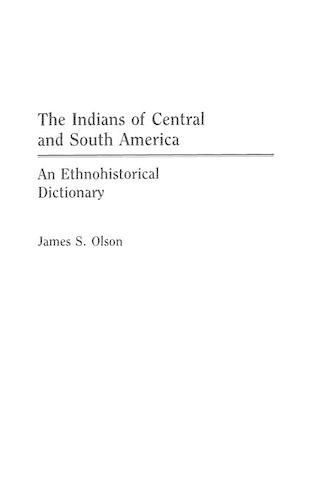
The Indians of Central and South America: An Ethnohistorical Dictionary
(Hardback)
Publishing Details
The Indians of Central and South America: An Ethnohistorical Dictionary
By (Author) James S. Olson
Bloomsbury Publishing PLC
Greenwood Press
17th June 1991
United States
Classifications
Tertiary Education
Non Fiction
972.800497
Physical Properties
Hardback
528
Width 156mm, Height 235mm
907g
Description
At a juncture in history when much interest and attention is focused on Central and South American political, ecological, social, and environmental concerns, this dictionary fills a major gap in reference materials relating to Amerindian tribes. This one-volume reference collects important information about the current status of the indigenous peoples of Central and South America and offers a chronology of the conquest of the Amerindian tribes; a list of tribes by country; and an extensive bibliography of surviving American Indian groups. Historical as well as contemporary descriptions of approximately 500 existing tribes or groups of people are provided along with several bibliographic citations at the conclusion of each entry. The focus of the volume is on those Indian groups that still maintain a sense of tribal identity. For the vast majority of his entries, James S. Olson draws material from the Smithsonian Institution's seven-volume Handbook of South American Indians as well as other classic resources of a broad, general nature. Much attention is also focused on the complicated question of South American languages and on the definition of what constitutes an Indian. Olson's introduction cites dozens of valuable reference works relating to these topics. Following the introduction, this survey of surviving Amerindians is divided into sections that contain entries for each existing tribe or group; an appendix listing tribes by country; the Amerindian conquest chronology; and a bibliographical essay. This unique reference work should be an important item for most public, college, and university libraries. It will be welcomed by reference librarians, historians, anthropologists, and their students.
Reviews
Olson's scope is the current status of Central and South American indigenous peoples whose cultural identity persists. Dictionary entries are ordered alphabetically by culture; "see" references link variant spellings or names to entry headings, many of which are inconsistent with Library of Congress Subject Headings. Depth and quality of information about cultures is necessarily uneven, being dependent on information available; but a consistent frame of reference (e.g. linguistic, geographic, subsistence, and ideological data) would have helped as minimal background for each account. Extinct cultures and thoroughly acculturated groups are included for no stated reason. Several entry headings are not culture names, but country-specific ethnic slurs against indigenous people, and these could have been treated separately or omitted. Brief source bibliographies follow historical entries. Spot checking disclosed a spelling error that created a bibliographic ghost ("Quichoan Linguistic Prehistory") following the "Quechua" entry, p.. 308. L. Campbell's Quichean Linguistic Prehistory (1977) is correctly cited below the "Quiche" entry, p.. 309. Appendixes include "tribes" listed by country, and a chronology of culture change, which omits such significant events as the rise of Sendero Luminoso (Shining Path) in Peru in 1980, which, although noted in Olson's introduction, is left out, again from the "Quechua" entry. A separate selected bibliography of "general" works, a regional mishmash ordered only by author name, is followed by specific bibliographies for selected cultures which include recent, high quality scholarly studies. Book citations throughout are annoyingly brief (author, title, andyear), but journal article citations are thorough. The totality does not measure up to two works compiled and edited by Olson in areas of his expertise as a historian, and to which he contributed some, -Choice
"Olson's scope is the current status of Central and South American indigenous peoples whose cultural identity persists. Dictionary entries are ordered alphabetically by culture; "see" references link variant spellings or names to entry headings, many of which are inconsistent with Library of Congress Subject Headings. Depth and quality of information about cultures is necessarily uneven, being dependent on information available; but a consistent frame of reference (e.g. linguistic, geographic, subsistence, and ideological data) would have helped as minimal background for each account. Extinct cultures and thoroughly acculturated groups are included for no stated reason. Several entry headings are not culture names, but country-specific ethnic slurs against indigenous people, and these could have been treated separately or omitted. Brief source bibliographies follow historical entries. Spot checking disclosed a spelling error that created a bibliographic ghost ("Quichoan Linguistic Prehistory") following the "Quechua" entry, p.. 308. L. Campbell's Quichean Linguistic Prehistory (1977) is correctly cited below the "Quiche" entry, p.. 309. Appendixes include "tribes" listed by country, and a chronology of culture change, which omits such significant events as the rise of Sendero Luminoso (Shining Path) in Peru in 1980, which, although noted in Olson's introduction, is left out, again from the "Quechua" entry. A separate selected bibliography of "general" works, a regional mishmash ordered only by author name, is followed by specific bibliographies for selected cultures which include recent, high quality scholarly studies. Book citations throughout are annoyingly brief (author, title, andyear), but journal article citations are thorough. The totality does not measure up to two works compiled and edited by Olson in areas of his expertise as a historian, and to which he contributed some,"-Choice
Author Bio
JAMES S. OLSON is Professor of History, Sam Houston State University, Huntsville, Texas. His previously published books include Historical Dictionary of the Vietnam War, and Historical Dictionary of the New Deal (Greenwood Press, 1988 and 1985, respectively). His upcoming Historical Dictionary of European Imperialism will be published in March 1991 by Greenwood Press. Professor Olson is now working on a historical dictionary of the Spanish Empire.
